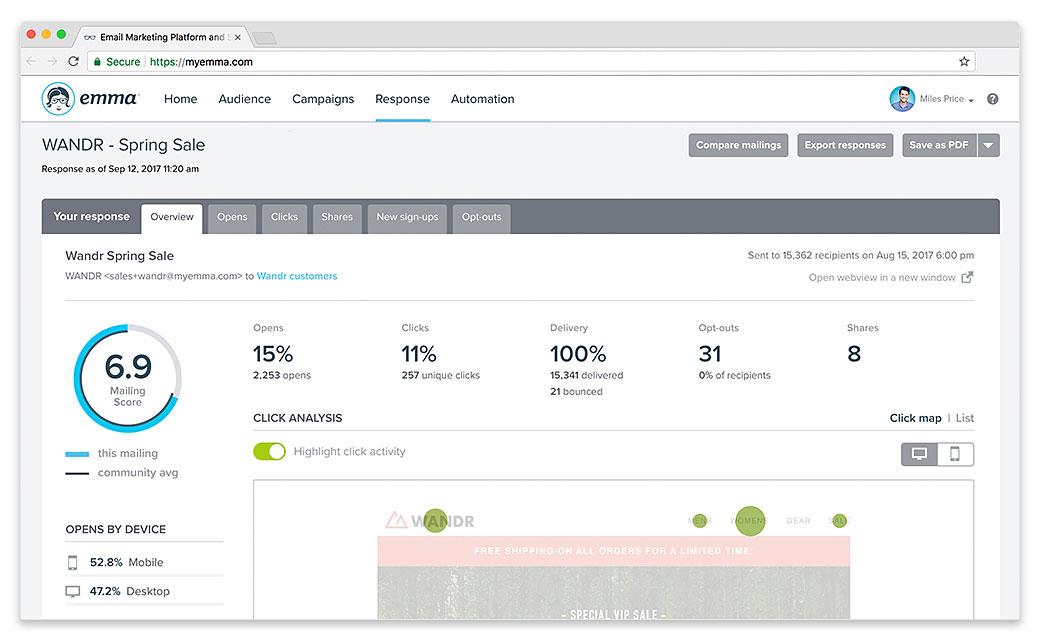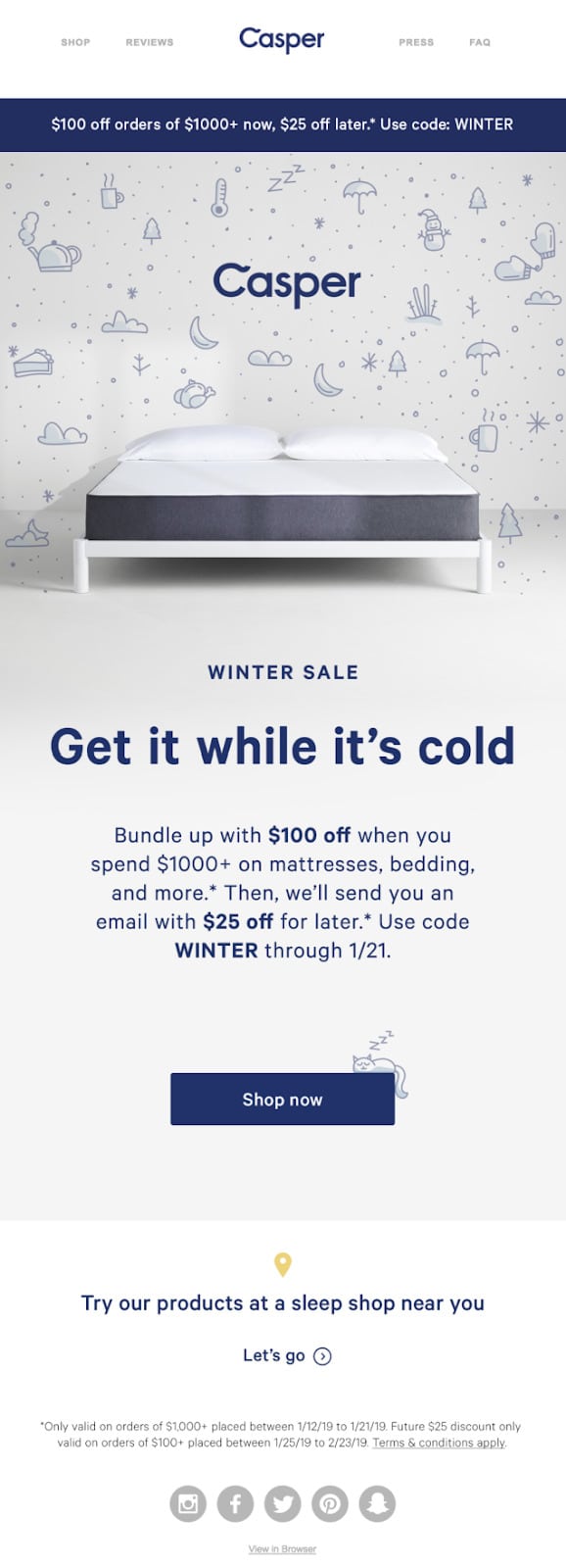What should your average email open rate be?
Article first published February 2018, updated August 2019.
What should your average email open rate be?
6 elements to consider when evaluating your email performance
It's a question we get all the time, even from seasoned email marketers...
What's a good open rate?
Sigh. While I'd love to be able to throw out a single percentage that rings true across the board – 15%, 25%, etc. – open rates are a bit more complicated than that. In fact, there is an endless number of variables to consider when evaluating whether you've achieved a "good" open rate.
Let's break it down.
First of all, what counts as an open?
To understand what's included in your open rate, it helps to know how tracking works.
Source: Emma
So here goes: The HTML version of your email includes images, like your logo, that display when the recipient opens the email. When you send through an ESP like Emma, there's also an invisible image in the HTML mailing that doesn't display but that gets 'called' just like the real images. A recipient opens your email, and the mailing calls our server to request the images. Our server delivers the image and counts the email as having been opened.
Most ESPs can also track opens for anyone who receives the plaintext version of your mailing and visits at least one of the links you've included in the email. (Remember that we automatically deliver the HTML version whenever we can, but we have a plaintext version ready in case someone's email client isn't set up to receive HTML.)
So in short, two actions...
1. Viewing the images in your email, or
2. Clicking through to your website using one of your mailing's links
... are trackable as opens. However, when it comes to your brand's actual open rates, they'll vary wildly based on a ton of factors.
What should your average email open rate be?
Since every business (and email marketing campaign) is different, it’s pointless to compete when it comes to average email open rates. Yes, even with other businesses in the same niche. One of the biggest reasons for this is that open rates are determined by your audience – and people are never the same.
However, it is good to have a ballpark figure that you can work with when determining your average email open rate. According to Campaign Monitor, a healthy email open rate can be anything from 20% - 40% (or higher). As you start your email marketing campaigns, your only competition is your previous campaign. In other words, always focus on beating your previous email open rate – not your competitor’s.
To set realistic benchmarks for your own average email open rate, you’ll have to take several factors into consideration. Let’s take a look at the 7 most important ones, shall we?
Factors that can influence open rates
1. What industry are you in?
This is often where marketers look first to determine whether or not their email open rates are on the right track: industry benchmarks.
On some level, it makes sense. Someone who sends internal communications (aka, emails people must open to keep their jobs) will probably get higher open rates than someone sending sales promos for their online store. Big-name publishers sending breaking news will probably get higher open rates than B2B companies pushing demos for high-dollar enterprise software. And so on, and so forth.
I will say this, though: Industry benchmarks MUST be taken with a grain of salt. There are a ton of variables that impact open rates beyond industry, like...
2. Did you use your typical sender name?
Your recipients will choose to open your email, mark it as spam, or send it to the trash bin based on three things: your subject line, your preheader text (if it's displayed in the email client they're using), and your sender name. Deviating from your typical sender name – by using the name of a person at your organization instead of your brand name, for instance – can boost or destroy your open rates depending on how recognizable that name is to your subscribers.
3. What was your subject line?
Similar to the sender name, your subject line can make or break your open rates. Just consider these stats...
-
69% of email recipients report messages as spam based solely on the subject line. (Convince & Convert)
-
Brands see a 18.7% decrease in open rates when the word “newsletter” is used. (Adestra)
-
Subject lines that create a sense of urgency can produce a 22% higher open rate. (Email Institute)
You can find millions of stats pointing to what subject line tricks might compel your audience to open, but the best way to find out is to test for yourself.
The following email from Casper had a subject line that reads "Shop this sale from under the covers." It's seasonal, brilliant, and meets customers right where they are on a cold winter day.
4. Who are you sending to?
You can't effectively evaluate your open rates without considering who actually got the email. Mass sends to your entire subscriber base will nearly always get lower opens than targeted emails, and even for campaigns sent to specific segments, your results will vary: For instance, an email to your frequent customers will do better than a re-engagement campaign to inactive subscribers.
5. What are you sending?
Is this a business-as-usual send, like a newsletter or sale, or something less common, like an event lineup or big announcement about your company? The timelier and more unique the information, the better your open rate will likely be.
6. What time of day are you sending?
While you might think you know the best time to send to your audience, many marketers find that their subscribers prefer to open at unexpected hours. Some B2B marketers, for instance, see better open rates on Sunday nights, perhaps because people are catching up before work the next day and there's less competition from similar brands.
7. What's your historical average?
Finally, one of the easiest ways to determine what's a "good" open rate for your brand is to use your past results as the benchmark. Take a look at your average open rates over time. Are they improving even as your list continues to grow, or are they declining as your list becomes fatigued? Those trends often signal exactly what you need to know to optimize your strategy for opens.
How to set realistic goals for your next campaign
Now that you’ve established the factors that influence your average email open rate, let’s take a look at how to set goals for your email marketing campaign. After all, an email open, crucial of a metric that it is, is not the only way to define the success of a campaign.
1. Define the action you want your readers to take.
Email marketing’s main objective is to get your readers to take a certain action after they have opened your email.
Source: Really Good Emails
You must determine from the beginning of the campaign what that action is. Is it:
-
To try a new product
-
Purchase something
-
Read a blog post
You can use email to achieve a lot of business goals as it is one of the main communication channels you can use to communicate with your customers.
2. Determine how you will measure your success.
Once you’ve determined your email marketing goals, you’ll also need to determine how you will measure your success. Examples of some metrics you can use include (but are not limited to):
-
Deliverability. This shows how many emails landed in their intended inboxes.
-
Bounce rates. Shows how many emails failed to reach their recipients.
-
Open rates. Indicates the percentage of emails opened.
-
Click-through rates. This is a metric that shows the percentage of emails (out of those opened) that got some clicks on a link inside the email.
-
Conversion rates. Shows the percentage of people that fulfilled the ultimate goal of your email marketing campaign.
Determining your key performance indicators (KPIs) will help you know which parts of the campaign are working well and which need to be improved upon.
3. Review and repeat.
Once all your metrics for the campaign are in, review the performance. Take special note of the aspects that worked so you can implement them in your next email campaign. Also, note those that didn’t perform so well so you can find out why they didn’t.
Repeat the process with the next campaign, making sure to implement the necessary adjustments.
Wrap up
Again, these are just some of the variables that impact your average email open rates. Your best bet for optimizing each of them is testing, so test, test, and test again – it's the very best way to get to know your audience and achieve the kind of open rates that are remarkable by any measure.
In summary, email open rates are mainly determined by
-
Industry
-
Audience
-
Offer
-
Subject line
Need more tips on what email marketing metrics you need to pay special attention to? Check out our article on the email metrics that really matter.
MOST RECENT ARTICLES
Want to engage your audience and grow your brand? Try Emma's robust easy-to-use product today.
















